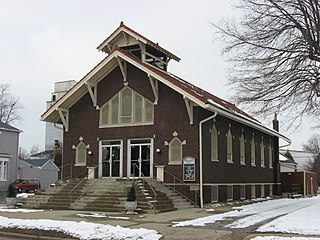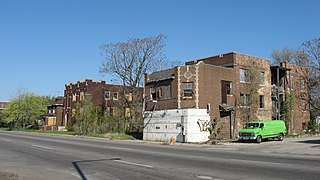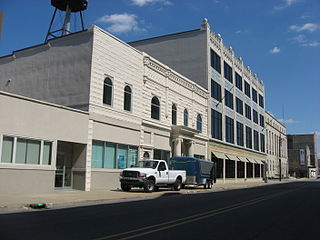
The Riverside Historic District is a U.S. historic district located in downtown Evansville, Indiana. It was added to the register in 1978 and roughly bounded by Southlane Drive, Walnut, Third, and Parrett Streets. It consists of 1,010 acres (4.1 km2) and 425 buildings. It is also known as the Riverside Neighborhood.

South Walnut Street Historic District is a national historic district located at Edinburgh, Johnson County, Indiana. The district encompasses 41 contributing buildings in a predominantly residential section of Edinburgh. It developed between about 1850 and 1935, and includes notable examples of Greek Revival, Italianate, Queen Anne, Romanesque Revival, and Bungalow / American Craftsman style architecture. The dwellings include tiny works' cottages, modest middle-class homes, and large expensive homes of the wealthy. Notable buildings include the First Christian Church and the Methodist Church.

Toner Historic District is a national historic district located at Edinburgh, Johnson County, Indiana. The district encompasses 66 contributing buildings in a predominantly residential section of Edinburgh. It developed between about 1845 and 1959, and includes notable examples of Gothic Revival, Italianate, Queen Anne, Colonial Revival, and Bungalow / American Craftsman style architecture. The dwellings include a collection of substantial homes with high historic integrity. Notable buildings include the Edinburgh Presbyterian Church (1916), and former marble shop and weight house.

Gary City Center Historic District is a national historic district located at Gary, Indiana. The district encompasses 60 contributing buildings and 2 contributing sites in Downtown Gary. It developed between about 1906 and 1944 includes notable examples of Tudor Revival, Late Gothic Revival, and Classical Revival style architecture. Notable buildings include the City Hall and Superior Courthouse (1927), the second Gary Land Company Building, Olympic Hotel, the "Modern Apartments", Dalton Apartments, Gary State Bank Building (1929), Hotel Gary (1926), City Methodist Church (1926), YWCA Building (1922), and former U.S. Post Office Building (1936).

Combs Addition Historic District is a national historic district located at Gary, Indiana. The district encompasses 99 contributing buildings in an exclusively residential section of Gary. They were built between 1928 and 1959 and are examples of the American Small House cottage movement with Colonial Revival and Tudor Revival design elements.

Lincoln Street Historic District is a national historic district located at Gary, Indiana. The district encompasses 239 contributing buildings in an exclusively residential section of Gary. They were largely built between 1910 and 1950, and many reflect the American Small House Movement. Architectural styles include examples of Colonial Revival, Late Gothic Revival, Spanish Colonial Revival, and Bungalow / American Craftsman architecture.

Jefferson Street Historic District is a national historic district located at Gary, Indiana. The district encompasses 81 contributing buildings in an exclusively residential section of Gary. They were largely built between 1922 and 1945, and many reflect the American Small House Movement. Architectural styles include examples of Colonial Revival, Tudor Revival, Late Gothic Revival, Spanish Colonial Revival, and Bungalow / American Craftsman architecture.

Horace Mann Historic District is a national historic district located at Gary, Indiana, United States. The district encompasses 130 contributing buildings and 1 contributing site in an exclusively residential section of Gary. They were largely built between 1919 and 1961, and include examples of Colonial Revival, Tudor Revival, Renaissance Revival, Spanish Colonial Revival, and Bungalow / American Craftsman style architecture.

West Fifth Avenue Apartments Historic District is a national historic district located at Gary, Indiana. The district encompasses 30 contributing buildings in a residential section of Gary. The buildings were built between 1922 and 1928, and consist of a dense group of brick apartment blocks mostly four stories tall. Architectural styles include examples of Colonial Revival, Renaissance Revival, Late Gothic Revival, and Commercial style architecture.

State Street Commercial Historic District is a national historic district located at Hammond, Lake County, Indiana. The district encompasses 28 contributing buildings in the central business district of Hammond. It developed between about 1885 and 1946, and includes notable example of Commercial, Classical Revival, Late Gothic Revival, and Art Deco style architecture. Notable buildings include the L. Fish Building (1927), Federal Building (1939), Lincoln Hotel (1923), Seifer Building (1925), and the Henderson Building (1902).

Hohman Avenue Commercial Historic District is a national historic district located at Hammond, Lake County, Indiana. The district encompasses 15 contributing buildings in the central business district of Hammond. It developed between about 1904 and 1956, and includes notable example of Romanesque Revival, Classical Revival, and Colonial Revival style architecture. Notable buildings include Knott's Apartments (1904), Emmerling Ambulance Garage (1918), Emmerling Building (1918), St. Joseph's Roman Catholic Church Complex, LaSalle Hotel, OK Building (1913), and the Hammond National Bank.

Roselawn–Forest Heights Historic District is a national historic district located at Hammond, Lake County, Indiana. The district encompasses 107 contributing buildings in a predominantly residential section of Hammond. It developed between about 1922 and 1962, and includes notable example of Colonial Revival, Tudor Revival, Bungalow / American Craftsman, and American Small House and eclectic styles of residential architecture. Located in the district is the separately listed George John Wolf House.

Glendale Park Historic District is a national historic district located at Hammond, Lake County, Indiana. The district encompasses 13 contributing buildings and 1 contributing site in an exclusively residential section of Hammond. It developed between about 1905 and 1926, and includes notable example of Colonial Revival, Tudor Revival, Prairie School and Bungalow / American Craftsman styles of residential architecture. The houses are arranged along a parkway with Glendale Park in the center.

Haskell and Barker Historic District is a national historic district located at Michigan City, LaPorte County, Indiana. The district encompasses 205 contributing buildings, 3 contributing structures, and 1 contributing object in a predominantly residential section of Michigan City. The district is named for the Haskell and Barker manufacturing company. It developed between about 1860 and 1960, and includes examples of Italianate, Gothic Revival, Queen Anne, Colonial Revival, Tudor Revival, and Bungalow / American Craftsman style architecture. Located in the district are the separately listed John H. Barker Mansion and First Congregational Church of Michigan City. Other notable buildings include the St. Stanislaus Koska Church (1922-1926), Rectory (1938), and Convent (1938), Consumer Service Company (1922), Michigan City School of Fine Arts (1908), Gilmore-Gardner Building (1925), Porter-Carrigan House (1895), Hutchinson House (1875), St Mary of the Immaculate Conception Catholic Church (1868) and Convent (1905), and Hartke House.

Plymouth Southside Historic District is a national historic district located at Plymouth, Marshall County, Indiana. The district encompasses 91 contributing buildings, 2 contributing structures, and 1 contributing object in a predominantly residential section of Plymouth. It developed between about 1853 and 1953, and includes examples of Italianate, Greek Revival, Queen Anne, Colonial Revival, and Tudor Revival style architecture. Notable contributing resources include the John McFarlin, Jr., House, Trinity United Methodist Church (1926), Bible Baptist Church (1894), Felke Florist and Greenhouse (1922), John Soice Residence, Westervelt-Marble Residence, and Edwards-Gambel Residence (1856).

John F. and Malissa Koontz House, also known as the Koontz House and Koontz-Engle House, is a historic home located at Indian Creek Township, Monroe County, Indiana. It was built in 1872, and is a two-story, Greek Revival style brick two-thirds I-house. It rests on a hammered limestone foundation and has a side-gable roof. Also on the property is the contributing brick walkway.

Millen-Chase-McCalla House, also known as the Topolgus Building, is a historic home located at Bloomington, Monroe County, Indiana. The original section was built in 1844, and now forms the two-story brick rear wing. The two-story, brick main section was added in 1854, to form a two-thirds I-house. The house was remodeled in 1871 in a combination of Greek Revival and Italianate style architecture. It rests on a limestone foundation and has a side-gable roof. The interior has undergone renovation for commercial uses a number of times; in 2011 it was rehabilitated for use as a restaurant.

Prospect Hill Historic District is a national historic district located at Bloomington, Monroe County, Indiana. The district encompasses 38 contributing buildings and 8 contributing structures in a predominantly residential section of Bloomington. It developed between about 1840 and 1936, and includes notable examples of Queen Anne, Colonial Revival, Tudor Revival, Mission Revival, and Bungalow/American Craftsman style architecture. Located in the district is the separately listed Blair-Dunning House.

North Liberty Historic District is a national historic district located at North Liberty, St. Joseph County, Indiana. The district encompasses 14 contributing buildings in the central business district of North Liberty. It was developed between about 1880 and 1960, and includes examples of Italianate, Classical Revival, and Art Moderne architecture. Notable buildings include the Worter Building (1892), Finch Block, Hoffman Block, L.W. Pommert Building (1920), North Liberty City Hall (1915), Masonic Hall, Community State Bank (1960), Starr Grocery, North Liberty State Bank, Service Garage, and Modern Speed Wash (1960).

Emerson Avenue Addition Historic District, also known as Emerson Heights Addition and Charles M. Cross Trust Clifford Avenue Addition, is a national historic district located at Indianapolis, Indiana. It encompasses 1,000 contributing buildings and 9 contributing objects in a planned residential section of Indianapolis. The district developed between about 1910 and 1949, and includes representative examples of Tudor Revival, Colonial Revival, and Bungalow / American Craftsman style residential architecture.
























